本文将针对仅编码器Transformer架构(Decoder-Only Transformer)的模型必备显存优化技术 KV Cache 进行讲解。

KV Cache 简介
KV Cache 是大模型推理性能优化的一个常用技术,该技术可以在不影响任何计算精度的前提下,通过空间换时间的思想,提高推理性能。
KV Cache 诞生的背景
对于仅编码器Transformer架构的模型的推理,我们给一个输入文本,模型会输出一个回答(长度为 N),其实该过程中执行了 N 次推理过程。即类 GPT 的仅编码器模型一次推理只输出一个token,输出的 token 会与输入 tokens 拼接在一起,然后作为下一次推理的输入,这样不断反复直到遇到终止符。
针对一个仅编码器Transformer架构的模型,假设用户输入为“recite the first law”,模型续写得到的输出为“A robot may not ”,模型的生成过程如下:
-
将“ecite the first law”输入模型,得到每个token的注意力表示。使用“law”的注意力表示,预测得到下一个token为“A”(实际还需要将该注意力表示映射成概率分布logits,为了方便叙述,我们忽略该步骤)。 -
将“A”拼接到原来的输入,得到“recite the first law A”,将其输入模型,得到注意力表示,使用“A”的注意力表示,预测得到下一个token为“robot”。 -
将“robot”拼接到原来的输入,依此类推,预测得到“robot”,最终得到“recite the first law A robot may not”

仅编码器Transformer架构的自回归模型为带 Masked 的 Self Attention。因此,在没有KV Cache的情况下,其计算过程如下所示。

正常情况下,Attention的计算公式如下:
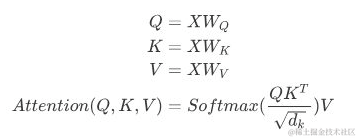
为了看上去方便,我们暂时忽略scale项,因此,Attention的计算公式如下所示(softmaxed 表示已经按行进行了softmax):


当变为矩阵时,softmax 会针对行进行计算,详细如下(softmaxed 表示已经按行进行了softmax):
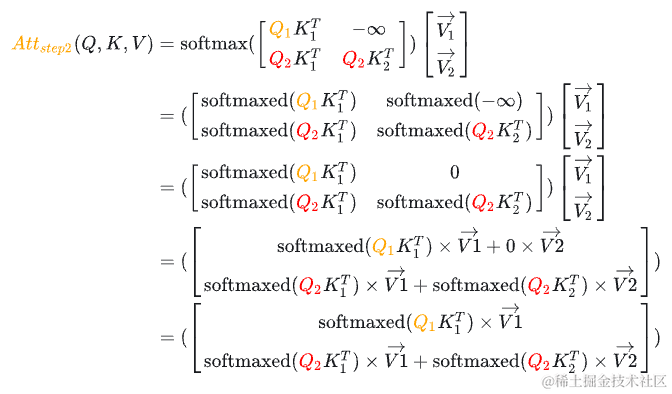
其中,表示 Attention 的第一行, 表示 Attention 的第二行。

对于,由于这个值会mask掉,你会发现, 在第二步参与的计算与第一步是完全一样的,并且 参与计算Attention时也仅仅依赖于 ,与 毫无关系。
对于, 参与计算Attention时也仅仅依赖于 ,与 毫无关系。

其计算方式如 Step2 所示。


其计算方式如 Step2 所示。

对于, 参与计算Attention时也仅仅依赖于 。
看上面图和公式,我们可以得出以下结论:
-
当前计算方式存在大量冗余计算,每一次生成新的Token都需要计算之前的KV。 -
的计算过程中,主要与 有关。 参与计算Attention时也仅仅依赖于 。 -
每一步中,其实只需要根据 计算 就可以,之前已经计算的Attention完全不需要重新计算。但是 K 和 V 是全程参与计算的,所以这里我们需要把每一步的 K 、 V 缓存起来。
KV Cache 步骤
正是因为 Self Attention 中带 Masked ,因此,在推理的时候,前面已经生成的 Token 不需要与后面的 Token 产生 Attention ,从而使得前面已经计算的 K 和 V 可以缓存起来。
一个典型的带有 KV cache 优化的生成大模型的推理过程包含了两个阶段:
1. 预填充阶段:输入一个prompt序列,为每个transformer层生成 key cache 和 value cache(KV cache)。
2. 解码阶段:使用并更新KV cache,一个接一个地生成token,当前生成的token词依赖于之前已经生成的token。
预填充阶段计算过程如下:
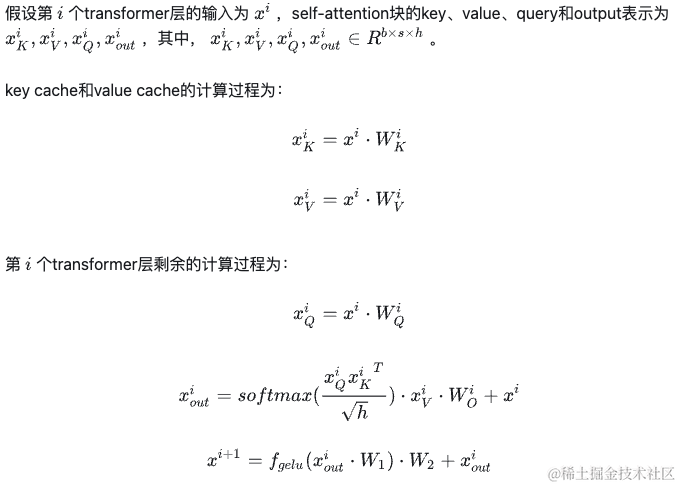
解码阶段计算过程如下:
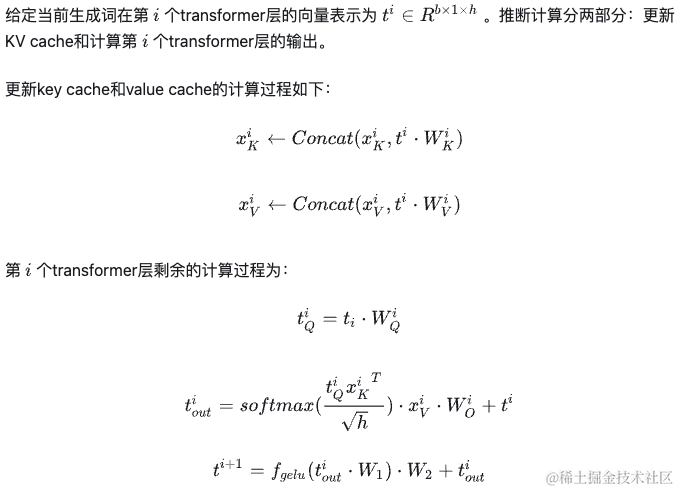
使不使用 KV Cache 的对比
下图展示了使用KV Cache和不使用KV Cache的对比,其中,紫色部分表示从缓存获取,灰色部分表示会被Masked。
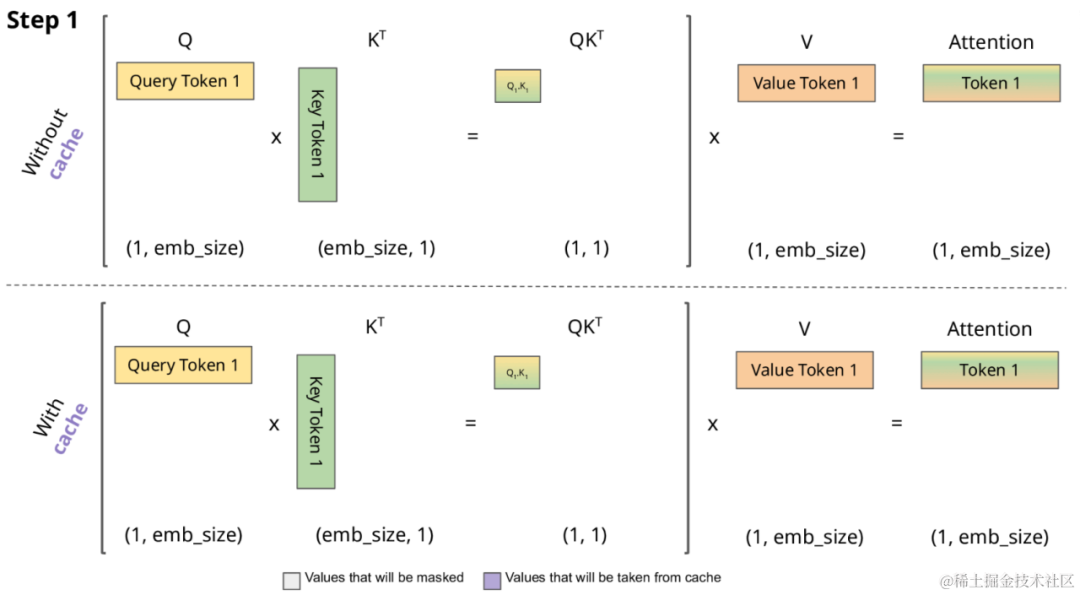
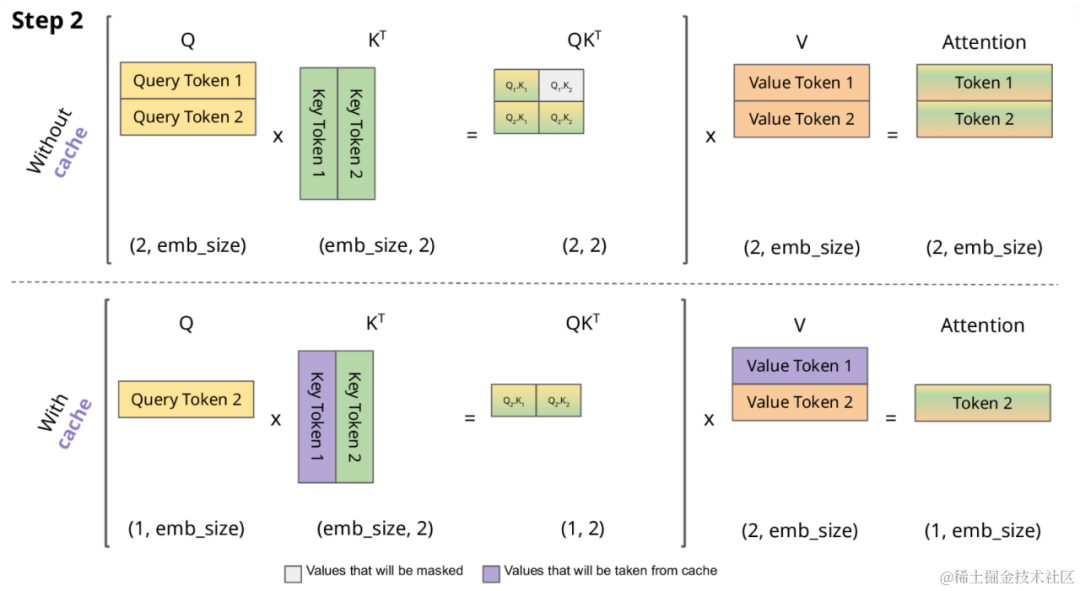
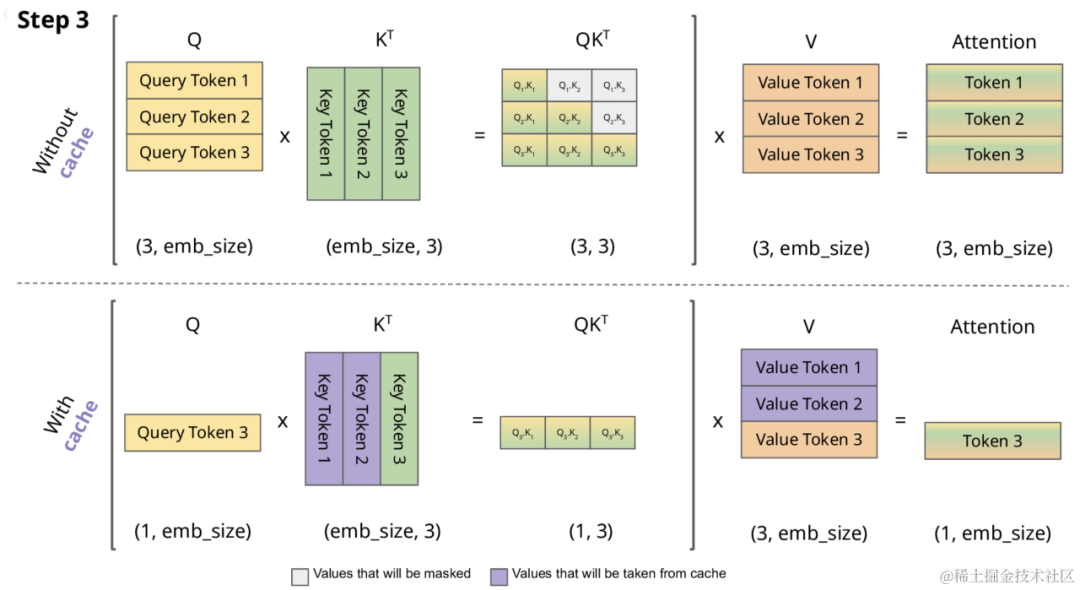
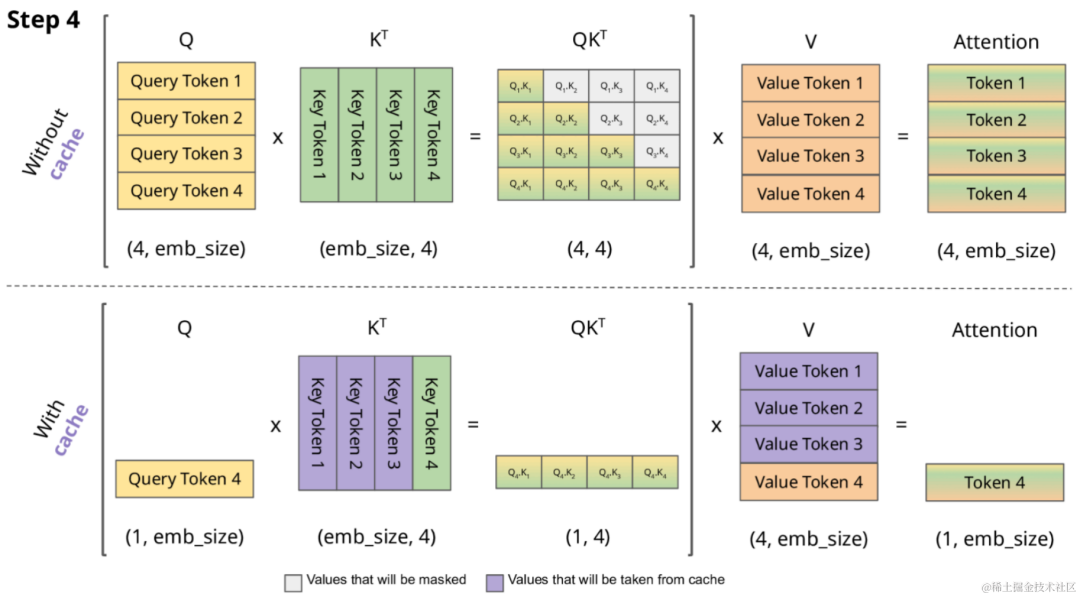
下面使用 transformers 来比较有 KV Cache 和没有 KV Cache的情况下,GPT-2的生成速度。
import numpy as np
import time
import torch
from transformers import AutoModelForCausalLM, AutoTokenizer
device = "cuda" if torch.cuda.is_available() else "cpu"
tokenizer = AutoTokenizer.from_pretrained("gpt2")
model = AutoModelForCausalLM.from_pretrained("gpt2").to(device)
for use_cache in (True, False):
times = []
for _ in range(10): # measuring 10 generations
start = time.time()
model.generate(**tokenizer("What is KV caching?", return_tensors="pt").to(device), use_cache=use_cache, max_new_tokens=1000)
times.append(time.time() - start)
print(f"{'with' if use_cache else 'without'} KV caching: {round(np.mean(times), 3)} +- {round(np.std(times), 3)} seconds")
运行结果:
-
使用 KV caching: 11.885 +- 0.272 秒 -
不使用 KV caching: 56.197 +- 1.855 秒
可以看到使不使用 KV cache 推理性能果差异显存。
使用 KV Cache 解码阶段计算量分析
FLOPs,floating point operations,表示浮点数运算次数,衡量了计算量的大小。
如何计算矩阵乘法的FLOPs呢?
对于 ,计算 ?? 需要进行 ? 次乘法运算和 ? 次加法运算,共计 2? 次浮点数运算,需要 的FLOPs。对于 ,计算 ?? 需要的浮点数运算次数为 。
下面来看看在一个 Token 生成过程中一层 Transformer 的计算量。
首先,分析 self-attention 块的计算,计算公式如下:
我们来看看不使用 KV Cache 时,假设输入数据的形状为 [b, s],隐藏层维度为 h,则输入的形状为 [b, s, h]。self-attention块的计算如下:
-
计算 ?,?,? :矩阵乘法的输入和输出形状为 [?,?,ℎ]×[ℎ,ℎ]→[?,?,ℎ]。计算量为 $ 3* bs2hh = 3∗2??ℎ^2=6??ℎ^2$ 。 -
矩阵乘法的输入和输出形状为 [?,ℎ???_???, ?, ???_ℎ???_ℎ?????_????]×[?, ℎ???_???, ???_ℎ???_ℎ?????_????, ?]→[?, ℎ???_???, ?, ?],计算量为 。 -
计算在 ? 上的加权 ?????⋅? ,矩阵乘法的输入和输出形状为 [?,ℎ???_???,?,?]×[?,ℎ???_???,?,???_ℎ???_ℎ?????_????]→[?,ℎ???_???,?,???_ℎ???_ℎ?????_????]。计算量为 。 -
attention后的线性映射,矩阵乘法的输入和输出形状为 [?,?,ℎ]×[ℎ,ℎ]→[?,?,ℎ]。计算量为 。
不使用 KV Cache 时,输入的形状为 [b, 1, h ],kv cache中含有 个 past word。self-attention块的计算如下:
-
计算 :矩阵乘法的输入和输出形状为 [?, 1, ℎ]×[ℎ, ℎ]→[?, 1, ℎ]。计算量为 。 -
矩阵乘法的输入和输出形状为 [b, head_num, 1, per_head_hidden_size]×[b, head_num, per_head_hidden_size, kv_length+1]→[b, head_num, 1, kv_length+1]。计算量为 。 -
计算在?上的加权 ?????·? ,矩阵乘法的输入和输出形状为 [b, head_num, 1, kv_length+1]×[b,head_num,kv_length+1,per_head_hidden_size]→[b,head_num,1,per_head_hidden_size]。计算量为 。 -
attention后的线性映射,矩阵乘法的输入和输出形状为 [?,1,ℎ]×[ℎ,ℎ]→[?,1,ℎ]。计算量为 。
接下来分析MLP块的计算,计算公式如下:
不使用 KV Cache 时:
-
第一个线性层,矩阵乘法的输入和输出形状为 [?,?,ℎ]×[ℎ,4ℎ]→[?,?,4ℎ]。计算量为 。 -
第二个线性层,矩阵乘法的输入和输出形状为 [?,?,4ℎ]×[4ℎ,ℎ]→[?,?,ℎ]。计算量为 。
使用 KV Cache 时:
-
第一个线性层,矩阵乘法的输入和输出形状为 [?, 1, ℎ]×[ℎ, 4ℎ]→[?,1,4ℎ]。计算量为 。 -
第二个线性层,矩阵乘法的输入和输出形状为 [?, 1, 4ℎ]×[4ℎ, ℎ]→[?,1,ℎ]。计算量为 。
将上述self-attention块和MLP块计算量相加,得到:
-
采用kv cache时,得到每个transformer层的计算量大约为 。 -
不采用kv cache时,得到每个transformer层的计算量大约为: 。
此外,另一个计算量的大头是logits的计算,将隐藏向量映射为词表大小。
-
采用kv cache时,矩阵乘法的输入和输出形状为 [?,1,ℎ]×[ℎ,?]→[?,1,?],计算量为 。 -
不采用kv cache时为,矩阵乘法的输入和输出形状为 [?,?,ℎ]×[ℎ,?]→[?,?,?],计算量为 。
KV Cache 显存占用分析
假设输入序列的长度为s ,输出序列的长度为n ,transformer层数为l,隐藏层维度 h,KV Cache 存储 kv_seq_len 个 KV value,形状为 [b, head_num, kv_seq_len, head_dim], 峰值kv_seq_len为 s+n ,以float16来保存KV cache,那么KV cache的峰值显存占用大小为 b(s+n)hl2*2=4blh(s+n) 。这里第一个 2 表示 K/V cache,第二个2表示float16占 2 个 bytes。
以GPT3-175B为例,对比KV cache与模型参数占用显存的大小。模型配置如下:
| 模型名 | 参数量 | 层数 | 隐藏维度 | 注意力头数 |
|---|---|---|---|---|
| GPT3 | 175B | 96 | 12288 | 96 |
GPT3 模型占用显存大小为350GB。假设批次大小b=64 ,输入序列长度s=512 ,输出序列长度n=32 ,则KV cache 峰值占用显存为 4blh(s+n) = 164,282,499,072 bytes ≈ 164 ?? ,大约是模型参数显存的0.5倍。
KV Cache 存在的问题以及优化措施
当将LLMs应用于无限输入流时,使用原始的 Dense Attention 会出现两个主要挑战:
-
上下文越长,那么矩阵占用的内存也会越多,不仅如此还会增加Decoder时候的延迟。 -
现有模型的长度外推能力有限,即当序列长度超出预训练期间设置的attention窗口大小时,其性能会下降。
因此,目前提出了一些优化方法,比如:使用滑动窗口的注意力机制,主要有如下几种方式。
-
一种方式是如下图 B 的窗口注意力(Window Attention):只缓存最近的 L 个 Token 的 KV。虽然推理效率很高,但一旦起始Token的键和值被驱逐,性能就会急剧下降。 -
一种方式是下图 C 的滑动窗口重计算(Sliding Window w/ Re-computation):根据每个新 Token 的 L 个最近 Token 重建 KV 状态。虽然它在长文本上表现良好,但其 的复杂性(源于上下文重新计算中的二次注意力)使其相当慢。
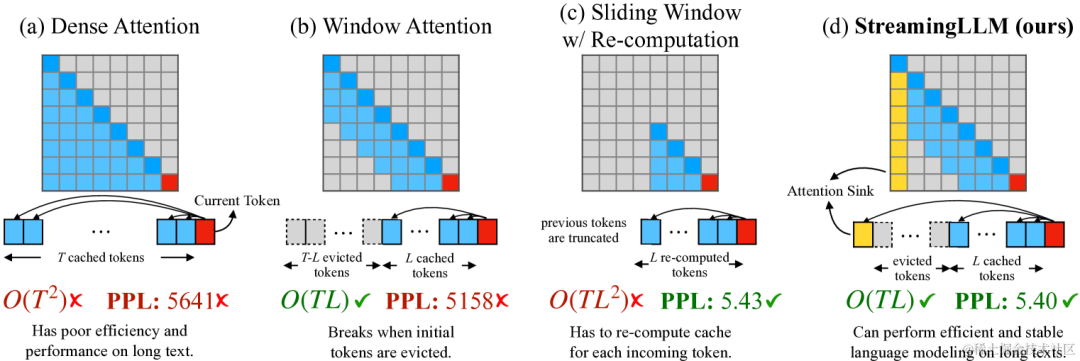
-
还有一种方式是StreamingLLM,在当前滑动窗口方法的基础上,重新引入了一些最初的 tokens 的KV在注意力计算中使用。StreamingLLM 中的KV缓存可以概念上分为两部分,如下图所示:(1)attention sink 是 4 个最初的 tokens,稳定了注意力计算;(2)Rolling KV Cache 保留了最近的token,这个窗口值是固定的。此外,还需要有些小改动来给attention注入位置信息,StreamingLLM就可以无缝地融入任何使用相对位置编码的自回归语言模型,如RoPE和ALiBi。
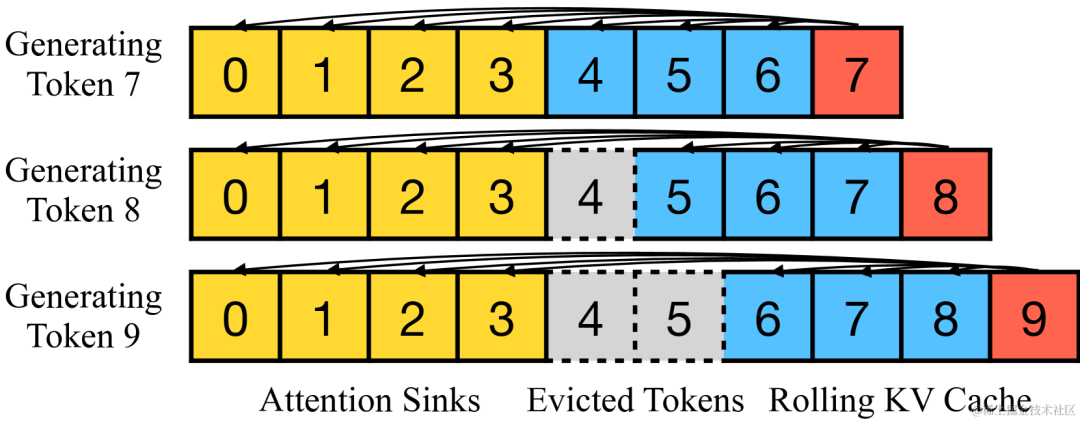
KV Cache 源码分析
GPT2 中 KV Cache 代码实现:
class GPT2Attention(nn.Module):
def forward(
self,
hidden_states: Optional[Tuple[torch.FloatTensor]],
layer_past: Optional[Tuple[torch.Tensor]] = None,
attention_mask: Optional[torch.FloatTensor] = None,
head_mask: Optional[torch.FloatTensor] = None,
encoder_hidden_states: Optional[torch.Tensor] = None,
encoder_attention_mask: Optional[torch.FloatTensor] = None,
use_cache: Optional[bool] = False,
output_attentions: Optional[bool] = False,
) -> Tuple[Union[torch.Tensor, Tuple[torch.Tensor]], ...]:
...
# 拆分 Q、K、V
query, key, value = self.c_attn(hidden_states).split(self.split_size, dim=2)
...
# [batch, sequence_len, embeded_dim] -> [batch, heads, sequence_len, head_dim]
query = self._split_heads(query, self.num_heads, self.head_dim) # 当前token对应的query
key = self._split_heads(key, self.num_heads, self.head_dim) # 当前token对应的key
value = self._split_heads(value, self.num_heads, self.head_dim) # 当前token对应的value
##################################
# KV Cache 核心代码逻辑
if layer_past is not None:
past_key, past_value = layer_past # 从 KV Cache 去数据
key = torch.cat((past_key, key), dim=-2) # 将当前token的key与历史的K拼接
value = torch.cat((past_value, value), dim=-2) # 将当前token的value与历史的V拼接
if use_cache is True:
present = (key, value) # 将数据存到 KV Cache
else:
present = None
##################################
...
# 使用当前token的query与K和V计算注意力表示
attn_output, attn_weights = self._attn(query, key, value, attention_mask, head_mask) # 返回att输出(激活)和权重
# 合并多头注意力
# attn_output: [batch, heads, sequence_len, head_dim] -> [batch, heads, embed_dim]
attn_output = self._merge_heads(attn_output, self.num_heads, self.head_dim)
attn_output = self.c_proj(attn_output)
attn_output = self.resid_dropout(attn_output)
outputs = (attn_output, present)
if output_attentions:
outputs += (attn_weights,)
return outputs # a, present, (attentions)
Baichuan2 中 KV Cache 代码实现:
class Attention(nn.Module):
def forward(
self,
hidden_states: torch.Tensor,
attention_mask: Optional[torch.Tensor] = None,
position_ids: Optional[torch.LongTensor] = None,
past_key_value: Optional[Tuple[torch.Tensor]] = None,
output_attentions: bool = False,
use_cache: bool = False,
) -> Tuple[torch.Tensor, Optional[torch.Tensor], Optional[Tuple[torch.Tensor]]]:
bsz, q_len, _ = hidden_states.size()
proj = self.W_pack(hidden_states)
proj = proj.unflatten(-1, (3, self.hidden_size)).unsqueeze(0).transpose(0, -2).squeeze(-2)
query_states = proj[0].view(bsz, q_len, self.num_heads, self.head_dim).transpose(1, 2)
key_states = proj[1].view(bsz, q_len, self.num_heads, self.head_dim).transpose(1, 2)
value_states = proj[2].view(bsz, q_len, self.num_heads, self.head_dim).transpose(1, 2)
kv_seq_len = key_states.shape[-2]
if past_key_value is not None:
kv_seq_len += past_key_value[0].shape[-2]
cos, sin = self.rotary_emb(value_states, seq_len=kv_seq_len)
query_states, key_states = apply_rotary_pos_emb(query_states, key_states, cos, sin, position_ids)
# [bsz, nh, t, hd]
if past_key_value is not None:
# 取出 KV Cache 中的值
# reuse k, v, self_attention
key_states = torch.cat([past_key_value[0], key_states], dim=2)
value_states = torch.cat([past_key_value[1], value_states], dim=2)
# 保存 KV Cache 中的值
past_key_value = (key_states, value_states) if use_cache else None
Huggingface Transformer 库中 LLaMA 中 KV Cache 代码实现:
class LlamaAttention(nn.Module):
...
def forward(
self,
hidden_states: torch.Tensor,
attention_mask: Optional[torch.Tensor] = None,
position_ids: Optional[torch.LongTensor] = None,
past_key_value: Optional[Cache] = None,
output_attentions: bool = False,
use_cache: bool = False,
cache_position: Optional[torch.LongTensor] = None,
**kwargs,
) -> Tuple[torch.Tensor, Optional[torch.Tensor], Optional[Tuple[torch.Tensor]]]:
...
past_key_value = getattr(self, "past_key_value", past_key_value)
cos, sin = self.rotary_emb(value_states, position_ids)
query_states, key_states = apply_rotary_pos_emb(query_states, key_states, cos, sin)
if past_key_value is not None:
# sin and cos are specific to RoPE models; cache_position needed for the static cache
cache_kwargs = {"sin": sin, "cos": cos, "cache_position": cache_position}
# 将当前 Token 的 kv 值更新到 KV Cache,并返回新的 KV
key_states, value_states = past_key_value.update(key_states, value_states, self.layer_idx, cache_kwargs)
...
return attn_output, attn_weights, past_key_value
Huggingface Transformer 库中对Cache进行了抽象,里面实现了各种Cache,如:生成模型默认的动态缓存DynamicCache、StaticCache 和 StreamingLLM 论文中提到的SinkCache。
@dataclass
class Cache:
"""
所有Cache的基础抽象类。实际数据结构由每个子类决定。
"""
def update(
self,
key_states: torch.Tensor,
value_states: torch.Tensor,
layer_idx: int,
cache_kwargs: Optional[Dict[str, Any]] = None,
) -> Tuple[torch.Tensor, torch.Tensor]:
"""
Updates the cache with the new `key_states` and `value_states` for the layer `layer_idx`.
Parameters:
key_states (`torch.Tensor`):
The new key states to cache.
value_states (`torch.Tensor`):
The new value states to cache.
layer_idx (`int`):
The index of the layer to cache the states for.
cache_kwargs (`Dict[str, Any]`, `optional`):
Additional arguments for the cache subclass. These are specific to each subclass and allow new types of
cache to be created.
Return:
A tuple containing the updated key and value states.
"""
raise NotImplementedError("Make sure to implement `update` in a subclass.")
def get_seq_length(self, layer_idx: Optional[int] = 0) -> int:
"""Returns the sequence length of the cached states. A layer index can be optionally passed."""
raise NotImplementedError("Make sure to implement `get_seq_length` in a subclass.")
def get_max_length(self) -> Optional[int]:
"""Returns the maximum sequence length of the cached states, if there is any."""
raise NotImplementedError("Make sure to implement `get_max_length` in a subclass.")
def get_usable_length(self, new_seq_length: int, layer_idx: Optional[int] = 0) -> int:
"""Given the sequence length of the new inputs, returns the usable length of the cache."""
# Cache without size limit -> all cache is usable
# Cache with size limit -> if the length cache plus the length of the new inputs is larger the maximum cache
# length, we will need to evict part of the cache (and thus not all cache is usable)
max_length = self.get_max_length()
previous_seq_length = self.get_seq_length(layer_idx)
if max_length is not None and previous_seq_length + new_seq_length > max_length:
return max_length - new_seq_length
return previous_seq_length
@property
def seen_tokens(self):
logger.warning_once(
"The `seen_tokens` attribute is deprecated and will be removed in v4.41. Use the `cache_position` "
"model input instead."
)
if hasattr(self, "_seen_tokens"):
return self._seen_tokens
else:
return None
class DynamicCache(Cache):
# 随着生成更多 Token 而动态增长的Cache。这是生成模型的默认设置。
# 它将键和值状态存储为张量列表,每层一个张量。每个张量的期望形状是
# [batch_size, num_heads, seq_len, head_dim]。
def update(
self,
key_states: torch.Tensor,
value_states: torch.Tensor,
layer_idx: int,
cache_kwargs: Optional[Dict[str, Any]] = None,
) -> Tuple[torch.Tensor, torch.Tensor]:
# Update the number of seen tokens
if layer_idx == 0:
self._seen_tokens += key_states.shape[-2]
# Update the cache
if len(self.key_cache) <= layer_idx:
self.key_cache.append(key_states)
self.value_cache.append(value_states)
else:
self.key_cache[layer_idx] = torch.cat([self.key_cache[layer_idx], key_states], dim=-2)
self.value_cache[layer_idx] = torch.cat([self.value_cache[layer_idx], value_states], dim=-2)
return self.key_cache[layer_idx], self.value_cache[layer_idx]
class StaticCache(Cache):
"""
与 torch.compile(model) 一起使用的静态 Cache 类
"""
...
def update(
self,
key_states: torch.Tensor,
value_states: torch.Tensor,
layer_idx: int,
cache_kwargs: Optional[Dict[str, Any]] = None,
) -> Tuple[torch.Tensor, torch.Tensor]:
"""
Updates the cache with the new `key_states` and `value_states` for the layer `layer_idx`.
使用张量进行索引是非常重要的,否则你会向设备引入一个副本。
Parameters:
key_states (`torch.Tensor`):
The new key states to cache.
value_states (`torch.Tensor`):
The new value states to cache.
layer_idx (`int`):
The index of the layer to cache the states for. Kept for backward compatibility
cache_kwargs (`Dict[str, Any]`, `optional`):
Additional arguments for the cache subclass. The `StaticCache` just needs the `q_len`
to know how much of the cache it should overwrite.
Return:
A tuple containing the updated key and value states.
"""
new_cache_positions = cache_kwargs.get("cache_position")
k_out = self.key_cache
v_out = self.value_cache
k_out[:, :, new_cache_positions] = key_states
v_out[:, :, new_cache_positions] = value_states
return k_out, v_out
class SinkCache(Cache):
"""
# 正如[Attention Sinks 论文](https://arxiv.org/abs/2309.17453)中所描述的缓存。
# 它允许模型生成超出其上下文窗口的长度,而不会失去会话的流畅性。
# 因为它抛弃了过去tokens,模型将失去生成依赖于被丢弃的上下文的tokens的能力。
# 它将键和值状态存储为张量列表,每层一个张量。每个张量的期望形状是
# [batch_size, num_heads, seq_len, head_dim]
"""
...
def update(
self,
key_states: torch.Tensor,
value_states: torch.Tensor,
layer_idx: int,
cache_kwargs: Optional[Dict[str, Any]] = None,
) -> Tuple[torch.Tensor, torch.Tensor]:
# Optional kwargs for `SinkCache` -- needed on models using RoPE. `partial_rotation_size` is used on models
# with partially rotated position embeddings, like Phi or Persimmon.
sin = cache_kwargs.get("sin")
cos = cache_kwargs.get("cos")
partial_rotation_size = cache_kwargs.get("partial_rotation_size")
using_rope = cos is not None and sin is not None
# Update the number of seen tokens
if layer_idx == 0:
self._seen_tokens += key_states.shape[-2]
# [bsz, num_heads, seq_len, head_dim]
if len(self.key_cache) <= layer_idx:
# Empty cache
self.key_cache.append(key_states)
self.value_cache.append(value_states)
elif key_states.shape[-2] + self.get_seq_length(layer_idx) < self.window_length:
# Growing cache
self.key_cache[layer_idx] = torch.cat([self.key_cache[layer_idx], key_states], dim=-2)
self.value_cache[layer_idx] = torch.cat([self.value_cache[layer_idx], value_states], dim=-2)
else:
# Shifting cache
keys_to_keep = self.key_cache[layer_idx][
:, :, -self.window_length + self.num_sink_tokens + key_states.shape[-2] :
]
# On RoPE models, we need to recompute the Key rotation as the tokens are shifted
if using_rope:
rerotation_cos, rerotation_sin = self._get_rerotation_cos_sin(
key_states, cos[: self.window_length], sin[: self.window_length]
)
if partial_rotation_size is not None:
keys_to_keep, keys_pass = (
keys_to_keep[..., :partial_rotation_size],
keys_to_keep[..., partial_rotation_size:],
)
keys_to_keep = self._apply_key_rotary_pos_emb(keys_to_keep, rerotation_cos, rerotation_sin)
if partial_rotation_size is not None:
keys_to_keep = torch.cat((keys_to_keep, keys_pass), dim=-1)
# Concatenate sink tokens, shifted & rotated tokens (if needed), and new tokens
sink_keys = self.key_cache[layer_idx][:, :, : self.num_sink_tokens]
self.key_cache[layer_idx] = torch.cat([sink_keys, keys_to_keep, key_states], dim=-2)
sink_values = self.value_cache[layer_idx][:, :, : self.num_sink_tokens]
values_to_keep = self.value_cache[layer_idx][
:, :, -self.window_length + self.num_sink_tokens + value_states.shape[-2] :
]
self.value_cache[layer_idx] = torch.cat([sink_values, values_to_keep, value_states], dim=-2)
return self.key_cache[layer_idx], self.value_cache[layer_idx]
从 GPT2 、 Baichuan2 和 LLaMA 的源码中可以看到 KV Cache 核心代码的实现就几行并不复杂,但是带来的收益却挺大。
结语
本文简要分析了 KV Cache 原理、源码以及计算量和显存占用,这是一种典型的通过空间换时间(计算)的技术,虽然并不复杂,但是现在基本上是仅编码器Transformer架构生成大语言模型必备优化技术。


